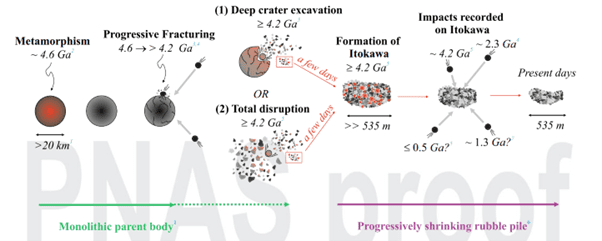Dust grains brought back by the Hayabusa mission from the asteroid 25413 Itokawa are a scientific goldmine, giving us a glimpse of a space rock in its natural environment, unaffected by passage through Earth’s atmosphere. Studying three of these grains has led one team to conclude Itokawa has a very different history from what we imagined, with big implications for planetary defense projects.
Itokawa is a rubble-pile asteroid. Rather than a single solid space rock, it’s a collection of loosely held-together boulders. This doesn’t sound very stable, and we might expect such an object to last no longer than its first encounter with another asteroid, however small.
However, in a new paper, Professor Fred Jourdan of Curtin University and co-authors flip that on its head. They find that Itokawa has been a rubble pile for approximately 4.2 billion years. Moreover, it spent a great deal of that time in the main asteroid belt, where it would certainly have been hit many times by objects large enough to blow apart a monolithic asteroid.
Rubble piles, it seems, can take more of a beating than solid rocks, their porosity allowing them to absorb much of the impact of a collision relatively unscathed. “Itokawa is like a giant space cushion, and very hard to destroy,” Jourdan said in a statement.
This has two implications for missions to protect the Earth against asteroid threats. Firstly, some of the ideas under consideration for dealing with an incoming asteroid might not work so well against highly resilient rubble piles. Moreover, Jourdan and co-authors point out that the longevity of rubble piles means they are probably a lot more common than previously thought. Itokawa’s life cycle may be pretty typical – a few hundred million years as a solid asteroid, before an object turns you into an almost invincible rubble pile, and you spend four billion years and counting in that state.

Itokawa’s lifecycle Image Credit: Jourdan et al/Proceedings of National Academy of Sciences
If rubble pile asteroids are the norm, not the exception, we’d better be planning how to deal with them – although Jourdan isn’t sure how easy it would be to tell which category an incoming rock fell into.
Provided we have plenty of warning, Jourdan told IFLScience the approach tried with Dimorphos should work well. The kinetic energy of a heavy object fired at a rubble pile asteroid will change its orbit even more than an equivalently sized monolith, since the rubble pile will be lighter. Even a miniscule change made early will cause an asteroid heading straight for Earth to instead be tens of thousands of kilometers off course when the crucial time comes.
An orbit like that would still hit Earth eventually, but as Jourdan told IFLScience; “Delay is good.” With years or decades to prepare for the next close approach, it would be easy to keep nudging the object until it posed no threat at all.
The problem, the team concludes, is if we become aware of an approaching rubble pile with only a few months’ notice. Hollywood may love it, but breaking the asteroid up is problematic, Jourdan told IFLScience, because some pieces would still hit Earth, but probably in different places from the original. Even if the damage was greatly reduced, Jourdan noted, having parts of an asteroid heading for Australia landing on China instead could be a great way to start a war that kills more people than the asteroid might have.
Unpopular as it might be, Jourdan thinks the only solution to a rubble pile discovered late is a nuclear bomb applied to one side. He hopes the shockwave will induce sufficient orbital shift, but acknowledges we don’t currently know if it would blow the object up instead.
“We need to experiment and see if it would work,” Jourdan told IFLScience.
The idea that something without strong bonds would be so lasting is counterintuitive, but Jourdan explained; “It’s all about energy conservation. The internal voids absorb the energy.”
The team’s conclusion is based on the ratios of Argon isotopes in two of Hayabusa’s grains, which indicate they initially cooled around 4.56 billion years ago, when a monolithic predecessor of Itokawa formed along with the solar system.
Then, 4.2 billion years ago, they underwent a disruption consistent with a collision that turned the solid asteroid into a rubble pile. No significant disturbance has happened since, indicating any subsequent collisions may have knocked a few pieces off the pile, but were not sufficient to raise the temperature more than 50 degrees or blow solid rock apart.
The paper is published in Proceedings Of The National Academy of Sciences
Source Link: Clues From Specks Of Asteroid Dust Could Reshape Our Planetary Defense